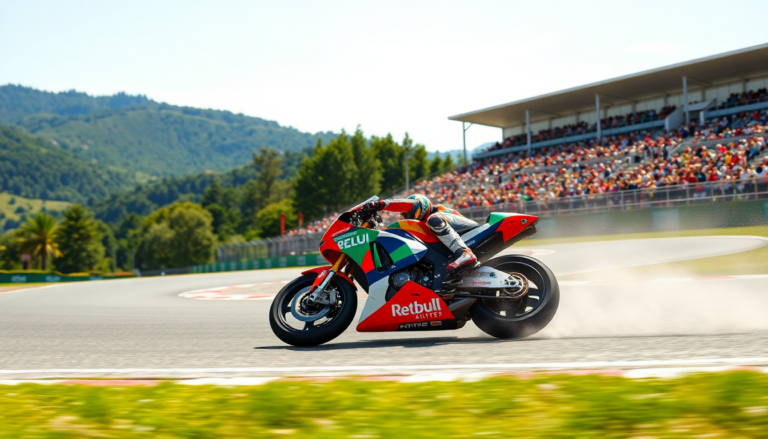Argomenti trattati
Understanding Grand Prix motorcycle racing
Grand Prix motorcycle racing stands as the pinnacle of motorcycle road racing, featuring events held on meticulously designed road circuits sanctioned by the Fédération Internationale de Motocyclisme (FIM). The history of independent motorcycle racing dates back to the early 20th century, with major national competitions often being labeled as Grand Prix events. The establishment of the FIM in 1949 marked a significant milestone, allowing for the coordination of rules and regulations that enabled selected races to contribute to an official World Championship. This championship is recognized as the oldest motorsport world championship.
The evolution of motorcycle design
Grand Prix motorcycles are specially crafted racing machines, not available for public purchase and not legal for street use. In contrast to production-based racing categories like the Superbike World Championship, these bikes are engineered purely for the racetrack. Since 2002, the premier division has been known as MotoGP, transitioning from the previous 500cc class. This lineage has maintained its historical significance within the official World Championship, although all racing classes hold official status.
Classes and competition structure
The championship is categorized into four distinct classes: MotoGP, Moto2, Moto3, and MotoE. The first three classes utilize four-stroke engines, while MotoE showcases electric motorcycles, reflecting the industry’s shift towards sustainable technology. This diversification of classes caters to various levels of skill and engine capacity, creating a competitive atmosphere that fosters talent across the spectrum of motorcycle racing.
Legendary figures in Grand Prix history
Among the most iconic figures in Grand Prix motorcycle racing is Giacomo Agostini, who boasts an impressive 15 titles and 122 race victories. He leads the all-time record in the top-tier series with eight championships, closely followed by Valentino Rossi, a contemporary legend with seven titles, and current active rider Marc Márquez, who has secured six championships. As of 2023, Rossi also holds the record for the highest number of top-flight race wins, totaling 89, cementing his status as one of the sport’s greatest competitors.
Organizing bodies and regulations
The first FIM Road Racing World Championship Grand Prix was held in 1949, with Dorna Sports currently owning the commercial rights while the FIM remains the governing body. The collaboration between teams, represented by the International Road Racing Teams Association (IRTA), and manufacturers, represented by the Motorcycle Sport Manufacturers Association (MSMA), ensures that the rules and regulations are updated and enforced fairly. Changes to technical regulations can be enacted by the MSMA, provided there is unanimous agreement among its members.
The evolution of racing classes
Throughout its history, Grand Prix racing has featured numerous classes based on engine size, including categories for 50cc, 80cc, 125cc, 250cc, 350cc, 500cc, and even 750cc solo machines. In the earlier decades, four-stroke engines were dominant across all classes. However, advancements in technology led to the rise of two-stroke engines, particularly in the smaller classes during the 1960s. In response to rising development costs, the FIM introduced new regulations in 1969, limiting the number of gears and cylinders across various classes, which significantly altered the competitive landscape.
Technological advancements and regulations
By the late 1990s, the dominance of two-stroke engines in the 500cc class prompted a major shift in regulations, leading to the introduction of four-stroke engines. In 2002, the MotoGP era officially began, allowing manufacturers to choose between two-stroke engines up to 500cc or four-stroke engines up to 990cc. This marked a turning point in motorcycle racing, as four-stroke engines quickly began to outperform their two-stroke counterparts, culminating in the complete disappearance of two-stroke machines from the MotoGP field by 2003.
The impact of rule changes
Subsequent years saw further adjustments to engine capacities and regulations to enhance the competitiveness and safety of the sport. The introduction of the Claiming Rule Teams (CRT) in 2012 aimed to provide independent teams with a more feasible path to compete, allowing them greater flexibility with engine usage and fuel capacity. The rebranding of this category to the Open class in 2014 marked another significant development in the ever-evolving landscape of MotoGP.
The challenges of racing
The MotoGP calendar consists of numerous circuits worldwide, with each race providing unique challenges. Riders must navigate varying weather conditions, track surfaces, and technical specifications of their machines. The introduction of ‘Sprint’ race events in 2023 added an exciting twist to the traditional race weekend, allowing riders to compete in shorter races on Saturdays, scoring points that contribute to the overall championship standings.
Tyre strategy and performance
Tyre selection plays a crucial role in a rider’s performance, with decisions typically made based on practice sessions and expected weather conditions. The balance between grip and durability often dictates the choice of tyre compounds, as softer options provide better traction but wear out more quickly. Teams must also adapt to the evolving rules surrounding tyre limits, which challenge competitors to optimize their strategies for race day.
Conclusion
Grand Prix motorcycle racing continues to be a captivating sport, showcasing the pinnacle of engineering, skill, and competition. With legends like Giacomo Agostini and Valentino Rossi paving the way, and new talents emerging regularly, the future of MotoGP looks bright. As technology evolves and regulations adapt, fans can expect the unpredictable excitement that only this high-octane sport can provide.

